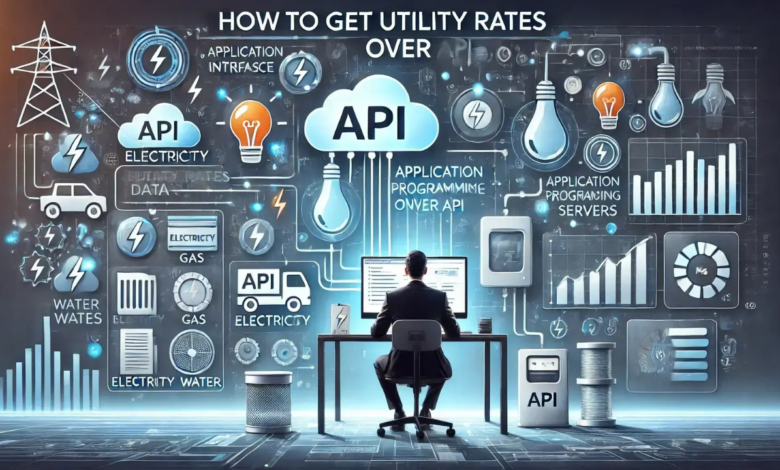How to Get Utility Rates Over API

In today’s tech-driven world, accessing utility rates through APIs has become a game-changer for developers, businesses, and energy consultants. Instead of manually scouring websites or dealing with outdated spreadsheets, APIs enable real-time access to comprehensive utility rate data. Whether you’re building an application for energy cost calculations, creating dashboards, or integrating rate data into renewable energy solutions, understanding “how to get utility rates over API” is essential.
This guide will walk you through the basics of utility rate APIs, how to choose the right one, and the steps to implement them effectively. By the end of this blog, you’ll be ready to leverage APIs to simplify your energy-related operations.
What Are Utility Rate APIs?
Utility rate APIs are application programming interfaces that provide real-time or static data on electricity, gas, or water rates for different regions and utilities. These APIs bridge the gap between utility companies and end-users, allowing seamless access to detailed rate structures, tariffs, and cost breakdowns.
With utility rate APIs, businesses can:
- Automate energy cost calculations.
- Access up-to-date rate information.
- Enhance energy management systems.
- Build energy savings calculators.
Popular providers like Genability, RateAcuity, and OpenEI offer robust APIs designed to meet various needs. By understanding “how to get utility rates over API,” you can transform how you handle energy data.
Why Use APIs for Utility Rates?
Before diving into how to get utility rates over API, let’s explore why APIs are the preferred choice for accessing this data:
Accuracy
APIs provide accurate and regularly updated information directly from utility databases.
Time Efficiency
Forget manual data entry or searching through multiple sources. APIs automate the entire process.
Customization
Many APIs allow filtering data by location, utility provider, or rate type, making it easy to tailor the information to your needs.
Scalability
Whether you need data for a single region or nationwide coverage, APIs can scale to your requirements.
Steps to Get Utility Rates Over API
If you’re ready to dive into “how to get utility rates over API,” here’s a step-by-step guide:
Identify Your Needs
Start by understanding why you need utility rate data. Are you developing a mobile app for consumers to compare energy costs? Or perhaps you’re creating tools for businesses to manage energy expenses? Clearly defining your purpose will help you choose the right API.
Choose the Right API Provider
Not all utility rate APIs are created equal. Here are a few popular options:
- Genability API: Perfect for businesses focused on renewable energy and cost analysis. It provides granular data, including rate structures and tariffs.
- OpenEI Utility Rates API: A free option for accessing basic utility rate data in the U.S.
- RateAcuity API: Ideal for businesses needing highly accurate and detailed data for electric and gas utilities.
When evaluating an API, consider factors like cost, data coverage, ease of integration, and documentation quality.
Sign Up for API Access
Most API providers require registration to grant access. After signing up, you’ll receive an API key—a unique identifier that authorizes your requests.
Read the Documentation
API documentation is your roadmap. It explains how to structure your requests, what parameters to include, and how to interpret the responses. Pay close attention to rate limits, authentication requirements, and data formatting.
Test API Endpoints
Use tools like Postman or cURL to test the API endpoints. For example, you might start with a basic query to fetch residential utility rates for a specific ZIP code. Testing ensures you understand how the API responds and allows you to troubleshoot any issues early.
Integrate the API
Once you’re confident in the API’s functionality, integrate it into your application. Depending on your use case, you may need to:
- Fetch data in real-time for live applications.
- Store data locally for analysis and reporting.
- Combine API data with other datasets for a comprehensive solution.
Monitor and Maintain
APIs require ongoing monitoring to ensure they perform as expected. Keep an eye on:
- Rate Limits: Avoid exceeding the API’s request limits.
- Data Updates: Ensure your application reflects the latest rate changes.
- Performance: Address any latency or downtime issues promptly.
Best Practices for Using Utility Rate APIs
When learning “how to get utility rates over API,” keep these best practices in mind:
Optimize API Requests
Minimize unnecessary calls by using filters and caching data where appropriate.
Ensure Data Security
Protect API keys and use HTTPS for secure data transfer.
Handle Errors Gracefully
Implement error-handling mechanisms to manage issues like rate limits or invalid requests.
Stay Updated
APIs evolve over time. Subscribe to provider updates to stay informed about changes or new features.
Real-World Applications
Understanding “how to get utility rates over API” opens doors to countless applications, including:
- Energy Management Systems: Monitor and optimize energy consumption based on current rates.
- Solar Installation Calculators: Estimate savings and ROI for solar panel installations.
- Consumer Apps: Enable users to compare utility costs across providers and regions.
- Billing Systems: Automate billing calculations for utilities and energy resellers.
Frequently Asked Questions (FAQs)
What is a utility rate API?
A utility rate API is a service that provides real-time or static data about utility rates, such as electricity, gas, or water tariffs. These APIs allow seamless access to rate data for integration into applications or systems.
How do I choose the best utility rate API?
To choose the right API, evaluate factors like data coverage, cost, ease of integration, and the level of detail provided. Popular options include Genability, RateAcuity, and OpenEI.
Are utility rate APIs free?
Some APIs, like OpenEI, offer free access to basic data. However, advanced APIs with detailed and extensive data, like Genability or RateAcuity, often come with subscription costs.
Can I use utility rate APIs for commercial projects?
Yes, most utility rate APIs are designed for commercial use. However, ensure you review the API’s terms of service to comply with licensing and usage guidelines.
Do utility rate APIs provide global data?
While some APIs focus on specific regions, like the U.S., others may offer international data. Check the API’s documentation for details about geographical coverage.
Conclusion
Getting utility rates over API is no longer a complex task, thanks to the availability of robust and user-friendly APIs. By integrating these tools into your workflows, you can save time, reduce errors, and unlock new opportunities for innovation in energy management.
Now that you know “how to get utility rates over API,” it’s time to explore your options, select the right provider, and start building smarter energy solutions. With the right API, the possibilities are endless. Leverage this technology today and transform your approach to energy data management.



